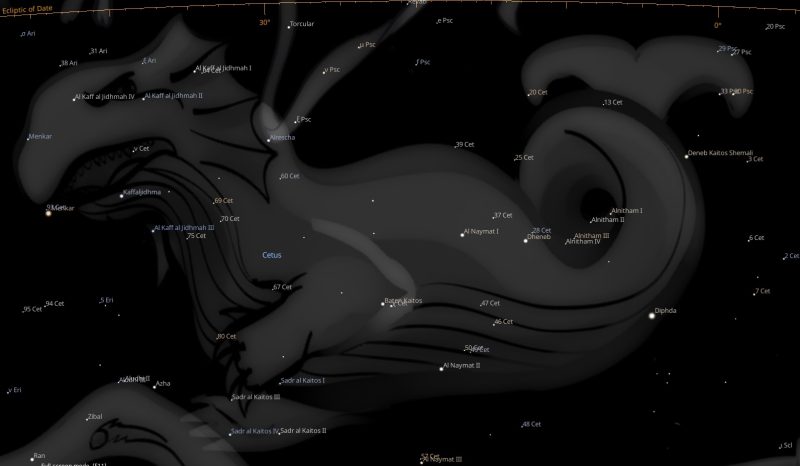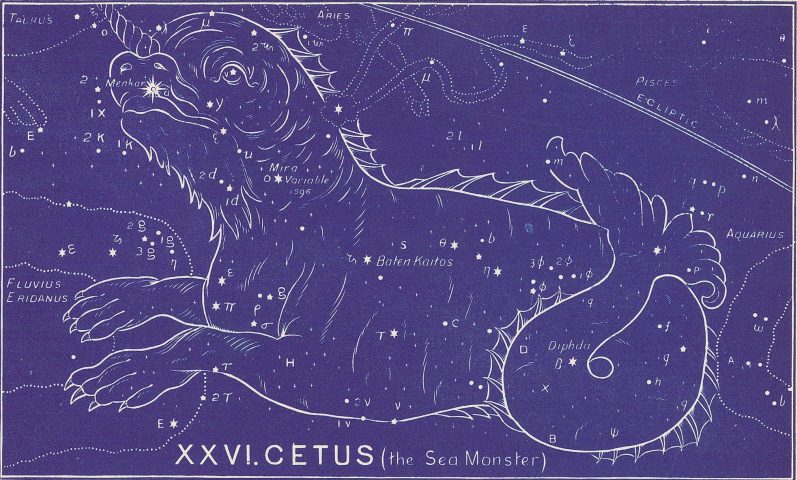FIXED STARS: Major Stars | 1000+ Stars | Constellations | About
Constellation Cetus the Sea Monster is a southern constellation bordering Aquarius, Pisces, Aries, Taurus, Eridanus, Fornax, Sculptor and the obsolete constellations Psalterium Georgii and Machina Electrica.
Cetus is one of the 48 constellations listed by Ptolemy in the 2nd century and remains one of the 88 modern constellations. It spans 45 degrees of the zodiac in the Signs of Aries and Taurus.
Abbreviation: Cet
Genitive: Ceti
Cetus Constellation Stars
| 2000 | B | Star Name | Mag. | Orb | ||
|---|---|---|---|---|---|---|
| 00♈55 | 01♈37 | ι Cet | Deneb Kaitos Shemali | K2 | 3.56 | 1°40′ |
| 02♈35 | 03♈17 | β Cet | Diphda, Deneb Kaitos | K0 | 2.04 | 2°10′ |
| 05♈53 | 06♈36 | φ1 Cet | Alnitham I | K0 | 4.77 | 1°00′ |
| 07♈15 | 07♈57 | φ2 Cet | Alnitham II | F7 | 5.17 | 1°00′ |
| 08♈22 | 09♈05 | φ3 Cet | Alnitham III | K4 | 5.35 | 1°00′ |
| 08♈57 | 09♈40 | φ4 Cet | Alnitham IV | G7 | 5.62 | 1°00′ |
| 11♈46 | 12♈28 | η Cet | Deneb Algenub | K2 | 3.46 | 1°40′ |
| 16♈14 | 16♈56 | θ Cet | Al Naymat I | K0 | 3.60 | 1°40′ |
| 17♈48 | 18♈30 | τ Cet | Al Naymat II | G8 | 3.49 | 1°40′ |
| 19♈26 | 20♈08 | υ Cet | Al Naymat III | K5 | 3.99 | 1°30′ |
| 21♈57 | 22♈39 | ζ Cet | Baten Kaitos | K2 | 3.74 | 1°30′ |
| 29♈43 | 00♉26 | ρ Cet | Sadr al Kaitos I | A0 | 4.88 | 1°00′ |
| 00♉06 | 00♉49 | σ Cet | Sadr al Kaitos II | F5 | 4.74 | 1°00′ |
| 01♉31 | 02♉14 | ο Cet | Mira | M5 | 3.04 | 1°50′ |
| 03♉21 | 04♉03 | ε Cet | Sadr al Kaitos III | F5 | 4.83 | 1°00′ |
| 03♉45 | 04♉28 | π Cet | Sadr al Kaitos IV | B7 | 4.24 | 1°10′ |
| 04♉03 | 04♉48 | ξ1 Cet | Al Kaff al Jidhmah I | G8 | 4.36 | 1°10′ |
| 07♉28 | 08♉11 | ξ2 Cet | Al Kaff al Jidhmah II | B9 | 4.30 | 1°10′ |
| 07♉35 | 08♉17 | δ Cet | Al Kaff al Jidhmah III | B2 | 4.08 | 1°10′ |
| 09♉26 | 10♉08 | γ Cet | Kaffaljidhma | A3 | 3.47 | 1°40′ |
| 11♉57 | 12♉39 | μ Cet | Al Kaff al Jidhmah IV | F1 | 4.27 | 1°10′ |
| 14♉19 | 15♉01 | α Cet | Menkar | M2 | 2.54 | 2°00′ |
| 15♉06 | 15♉48 | λ Cet | Menkib | B6 | 4.71 | 1°00′ |
Cetus Astrology
Manilius (@ 35 AD)
The Whale, who now doth thro the Skies pursue
With eager haste, as thro’ the injur’d Flood
The fair Andromeda, and still thirsts for Blood.
And He that then is born shall be inclin’d
To spoil the Sea, and kill the Scaly Kind,
No Fish shall swim secure whilst Nets can sweep
The troubled Ocean, and confine the Deep:
Those that but now could wanton or’e the Main
Shall lye fast bound, and wonder at their chain;
Till with a touch He shall the Cords command,
And draw the Dancing Captives to the Land.
Or whilst He shoals expects e’en midst the Flood
Destroy, and stain the Ocean with their Blood.
Yet then his works not cease, or pains decay,
His various Arts encreasing with his prey:
For on the Shore He shall his spoil divide
For different uses. This when lightly dry’d
Is better Meat; and that when moist is good,
Whilst other parts are hardned into Food.
Could Gluttons see, they would not bear the sight
Of preparations for their Appetite,
Whilst Blood and Guts in a polluted Mass
Lye mixt, and are corrupted into Sauce;
Till all in filthy Gore distils to treat
The fashionable Palate of the Great.
Or if to meaner Arts his Thoughts encline,
Then Salt’s his care; he shall the Floods confine
In narrow Pitts, and to the Beams expose,
Till what was liquid now a solid grows,
Then lay the crusted froth with careful hand
In heaps, and cleanse it, and divide the Sand.
And thus the brackish and unwholesom Flood
Proves vital Salt, and Poyson’s turn’d to Food. [1]
Maternus
In the last degree of Pisces on the left side there arises Belua, which is called Cetus by the Greeks. Those who are born with this constellation rising will be fishermen but of large fishes. For these persons will catch seals, sea-dogs (sharks), sword fish, tuna, and crocodiles. They will also have jobs that are from the seas or from salted fish or from fish-sauce, and they will trade in these things. But if this constellation is in the DSC, and if Mars aspects this house, while swimming in a river or in the sea, they will be eaten by crocodiles or by [sea-] dogs and sea monsters of that sort. [2]
Robson
Legend. Cetus represents the sea monster or whale sent by Neptune to devour Andromeda (see ANDROMEDA).
Influence. According to Ptolemy this constellation is like Saturn. It is said to cause laziness and idleness, but to confer an emotional and charitable nature, with the ability to command.
Magical. Makes one amiable, prudent, happy by sea and land, and helps recover lost goods. [3]
Noonan
Now called Cetus (Cet), the stars of this constellation are said to have a nature akin to that of Saturn by Ptolemy when writing in Tetrabiblos. However, he was likely referring only to Menkar in this regard, Many of the brighter stars of this constellation have a Martian nature, confirming the opinion of classical astrologers that the constellation itself is correlative with the ability to command, especially in war. [4]
Allen
Cetus, the Whale or Sea Monster, is the French Baleine, the Italian Balena, and the German Wallfisch.
This constellation has been identified, at least since Aratos’ day, with the fabled creature sent to devour Andromeda, but turned to stone at the sight of the Medusa’s head in the hand of Perseus. Equally veracious additions to the story, from Pliny [H. N. IX.11] and Solinus, are that the monster’s bones were brought to Rome by Scaurus, the skeleton measuring forty feet in length and the vertebrae six feet in circumference; from Saint Jerome, who wrote that he had seen them at Tyre; and from Pausanias, who described a nearby spring that was red with the monster’s blood. But the legend in which Cetus figured seems to have been current on the Euphrates long before our era; and, descending to Euripides and Sophocles, appeared in their dramas, as also in much subsequent literature.
Thus in these, as, in fact, in all delineations, it has been a strange and ferocious marine creature, in later times associated with the story of Andromeda, and at first, perhaps, was the Euphratean Tiāmat, of which other forms were Draco, Hydra, and Serpens; indeed, some have thought that our Draco was Andromeda’s foe because of its proximity to the other characters of the legend.
Cetus is sometimes represented swimming in the River Eridanus, although usually as resting on the bank with fore paws in the water; its head, directly under Aries, marked by an irregular pentagon of stars, and its body stretching from the bend in Eridanus to that in the Stream from the Urn. It occupies a space of 50° in length by 20° in breadth, and so is one of the most extended of the sky figures; yet it shows no star larger than of the 2nd magnitude, and only one of that lustre.
Argelander enumerates 98 stars in the constellation, and Heis 162.
The 1515 Almagest and the Alfonsine Tables called it Balaena, but Firmicus [Mathesis, VIII.17.5] said Belua, the Beast or Monster, a more appropriate name than ours. Bayer mentioned it as Draco, and drew it so, but without wings; he also cited for it Leo, Monstrum marinum, Ursus marinus, Orphas, and Orphus; and Grotius quoted Gibbus, Humped, from anonymous writers.
The Arabian astronomers of course knew the Greek constellation and called it Al Ḳeṭus, from which have come Elketos, Elkaitos, and Elkaitus; but their predecessors, who had not heard of the Royal Family and its foe, separated these stars into three very different asterisms. Those in the head, α, γ, δ, λ, μ, ξ1and ξ2, were Al Kaff al Jidhmah, the Part of a Hand, from a fancied resemblance to their Stained Hand, our Cassiopeia; η, θ, τ, ζ, and υ, in the body of our Cetus, were Al Naʽāmāt, the Hen Ostriches; and the four in a straight line of 3° length across the tail, all lettered ϕ, were Al Niṭhām, the Necklace.
Although an old constellation, Cetus is by no means of special interest, except as possessing the south pole of the Milky Way and the Wonderful Star, the variable Mira; and from the fact that it is a condensation point of nebulae directly across the sphere from Virgo, also noted in this respect. [5]
Bullinger
This is what we see in the second section of the chapter, the second constellation in ARIES. The picture is that of a great sea-monster, the largest of all the constellations. It is the natural enemy of fishes, hence it is placed here in connection with this last chapter, in which fishes are so prominent. It is situated very low down among the constellations–far away towards the south or lower regions of the sky.
Its name in the Denderah Zodiac is Knem, which means subdued. It is pictured as a monstrous head, trodden under foot by the swine, the natural enemy of the serpent. The hawk also (another enemy of the serpent) is over this figure, crowned with a mortar, denoting bruising.
It consists of 97 stars, of which two are of the 2nd magnitude, eight of the 3rd, nine of the 4th, etc. The names of the stars interpret for us infallibly the meaning of the picture.
The brightest star, α (in the upper mandible), is named Menikar, and means the bound or chained enemy. The next, β (in the tail), is called Diphda, or Deneb Kaitos, overthrown, or thrust down. The star ο (in the neck) is named Mira, which means THE REBEL. Its names is ominous, for the star is one of the most remarkable. It is very bright, but it was not till 1596 that it was discovered to be variable. It disappears periodically seven times in six years! It continues at its brightest for fifteen days together. M. Bade says that during 334 days it shines with its greatest light, then it diminishes, till it entirely disappears for some time (to the naked eye). In fact, during that period it passes through several degrees of magnitude, both increasing and diminishing. Indeed its variableness is so great as to make it appear unsteady! [6]
References
- Astronomica, Manilius, 1st century AD, Book 5, XXXIII.
- Mathesis, Julius Firmicus Maternus, 336 AD, viii.17.5.
- Fixed Stars and Constellations in Astrology, Vivian E. Robson, 1923, p.38, 231.
- Fixed Stars and Judicial Astrology, George Noonan, 1990, p.57.
- Star Names: Their Lore and Meaning, Richard H. Allen, 1889, p.160-165.
- The Witness of the Stars, E. W. Bullinger, 1893, Cetus (the Sea Monster).


